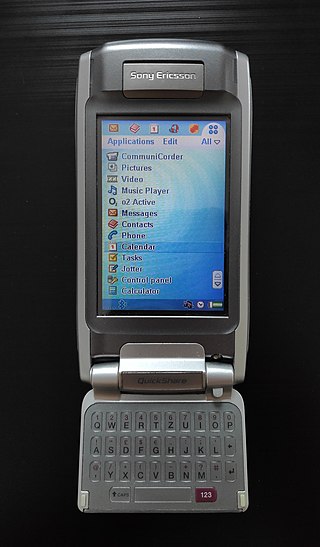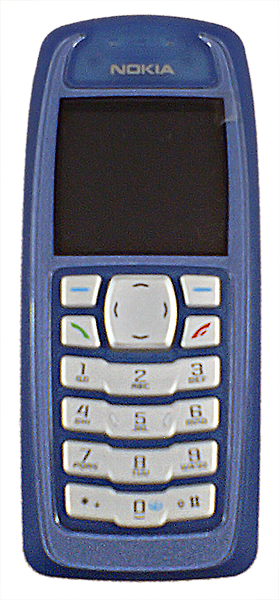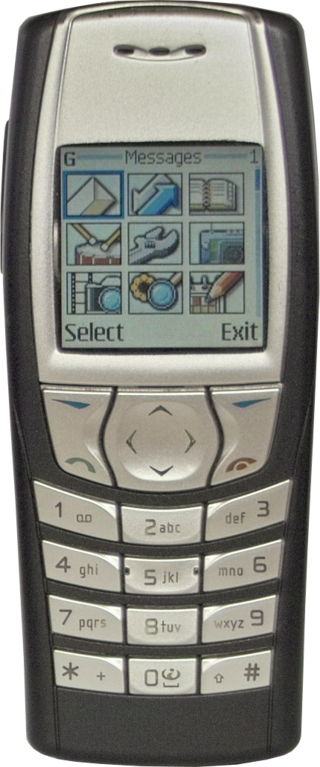
The Amiga 500, also known as the A500, is the first low-end version of the Amiga home computer. It contains the same Motorola 68000 as the Amiga 1000, as well as the same graphics and sound coprocessors, but is in a smaller case similar to that of the Commodore 128.
Color depth or colour depth, also known as bit depth, is either the number of bits used to indicate the color of a single pixel, or the number of bits used for each color component of a single pixel. When referring to a pixel, the concept can be defined as bits per pixel (bpp). When referring to a color component, the concept can be defined as bits per component, bits per channel, bits per color, and also bits per pixel component, bits per color channel or bits per sample (bps). Modern standards tend to use bits per component, but historical lower-depth systems used bits per pixel more often.
The Nokia 7250 is a mobile phone handset manufactured by Nokia. Announced in 2002 and released for sale in February 2003, it was designed at Nokia Design Center in California, by the Bulgarian-American designer Miki Mehandjiysky. The Nokia 7250 is notable for its unconventional design, striking colours and integrated digital camera, and also had Xpress-On covers. It was the successor of Nokia 7210.

The ThomsonMO5 is a home computer introduced in France in June 1984 to compete against systems such as the ZX Spectrum and Commodore 64. It had a release price of 2390 FF.

The Sony Ericsson P910 is a smartphone by Sony Ericsson introduced in 2004 and the successor of the Sony Ericsson P900. The P910 has a full QWERTY keyboard on the back of the flip. The biggest change from the P900 to the P910 is that the P910 supports Memory Stick PRO Duo and the phone's internal memory has been upped from 16 MB to 64 MB. Although Memory Stick PRO Duo comes in larger capacities, the maximum supported by the P910i is 2 GB. It is powered by an ARM9 processor clocked at 156 MHz and runs the Symbian OS with the UIQ graphical user interface. Also, the touchscreen displays 262,144 colours, as opposed to the P900's 65,536 (16-bit). It comes in three versions:

The Nokia 3100 is a triband-GSM mobile phone announced on 17 June 2003 as an entry-level phone from Nokia and released in September 2003, designed primarily for the newer generation of marketing audience.

The Nokia 3200 is a mobile phone by Nokia, part of the Nokia Expression (youth) series and announced on 12 September 2003. It is based on the Nokia Series 40 platform. The phone is an update of the Nokia 3100, while adding features from the Nokia 7250i and 6610i. The phone's feature set was very similar to the 7250i and 6610i, but featured different software and firmware installed, and was sold at a lower price than the 7250i or 6610i. Of the three phones, the 3200 was mainly targeted towards the youth market, the 7250i towards fashion-conscious users, and the 6610i towards business users. Core features include an XHTML browser, alarm clock, flashlight, EDGE and FM stereo radio with a 128 × 128 12-bit (4096) color screen. The phone has multimedia features such as picture and text messaging. Features carried over from the Nokia 3100 include ringer profiles and voice memo capability. It also has Java games. The phone has an extensive calendar with a lunar calendar. The flashlight is located under the phone and can be activated by holding the "star" (asterisk) key. The camera is on the back of the phone. The 3200 can also play both polyphonic and monophonic ringtones. The phone's visual interface in its menu system is similar to that of the Nokia 3100, using large, static icons rather than animated ones.

Hold-And-Modify, usually abbreviated as HAM, is a display mode of the Commodore Amiga computer. It uses a highly unusual technique to express the color of pixels, allowing many more colors to appear on screen than would otherwise be possible. HAM mode was commonly used to display digitized photographs or video frames, bitmap art and occasionally animation. At the time of the Amiga's launch in 1985, this near-photorealistic display was unprecedented for a home computer and it was widely used to demonstrate the Amiga's graphical capability. However, HAM has significant technical limitations which prevent it from being used as a general purpose display mode.
The O2 Xda brand was a range of Windows Mobile PDA phones, marketed by O2, developed by O2 Asia and manufactured by multiple OEMs (mainly HTC, Quanta and Arima). The first model was released in June 2002. The last models came to market in 2008. The "X" represents convergence of voice and information/data within one product; the "DA" stands for "Digital Assistant", as in PDA. The name of XDA Developers is derived from it.

The Nokia 6610 is a handset by Nokia that uses the Series 40 platform and J2ME (Java). The device features text and picture messaging, a WAP browser, Stereo FM radio, Polyphonic ringtones and a 128x128, 4096-colour display. It is essentially the same phone feature-wise as the Nokia 7210, the 6610 being a more business-oriented version with a more conservatively-styled face plate and keypad layout, in contrast with the fashion-oriented 7210. It was introduced at CommunicAsia in June 2002 and was released in Q3 of the year.
The Nokia 6131/Nokia 6133 is a Nokia clamshell phone introduced by Nokia in February 2006.

The Nokia 6111 is a mid-level GSM mobile phone released in June 2005. It sold in Asia, Europe, Australia, Brazil and in Mexico, but was not taken by any carriers in the United States.

The Nokia N93i is a smartphone produced by Nokia, announced on 8 January 2007 and released the same month. It is part of the Nseries line and is a redesign of the Nokia N93. The N93i runs on Symbian OS version 9.1, with the S60 3rd Edition user interface. Like the N93, it is a clamshell and swivel design with a camera and landscape position.
The Nokia 6000 series or Classic Business series is range of mobile phones marketed by Nokia. This family of phones is notable for their conservative, unisex designs, making them popular with business users.
The Nokia 6800 series are a selection of Nokia Series 40 phones with an unusual fold-out QWERTY keyboard. This type of keyboard is also used in the more recent Nokia Series 60 Symbian-based Nokia E70. These phones were marketed as "messaging devices": all had built-in email clients, and some had BlackBerry support.
PenTile matrix is a family of patented subpixel matrix schemes used in electronic device displays. PenTile is a trademark of Samsung. PenTile matrices are used in AMOLED and LCD displays.
The Nokia 7210 is a handset by Nokia, built on the Series 40 1st Edition software platform and enabled with J2ME (Java). The device features text and picture messaging, WAP browser, Stereo FM radio, Polyphonic ringtones, two preinstalled games and a 1.5", 128x128 pixel, 4,096 color display. It was the first Nokia phone for the mass market with a colour display and with polyphonic ringtones.









